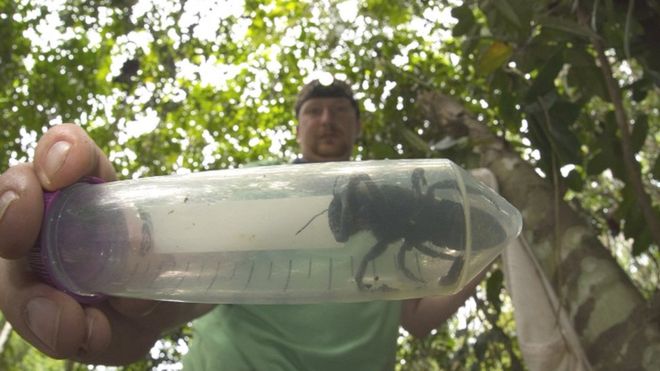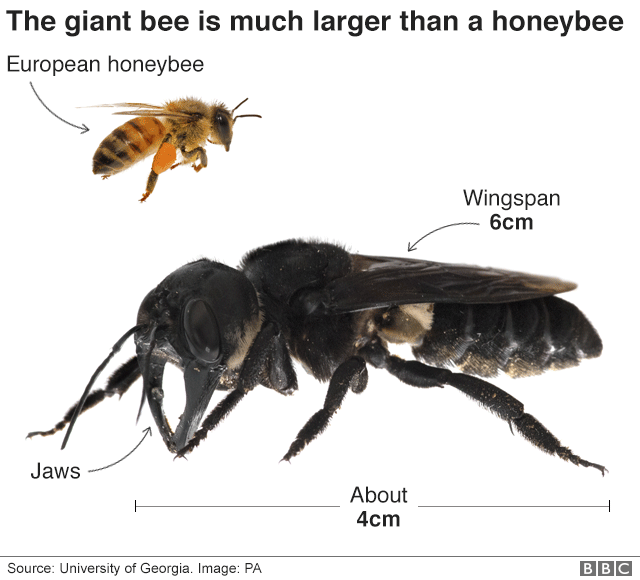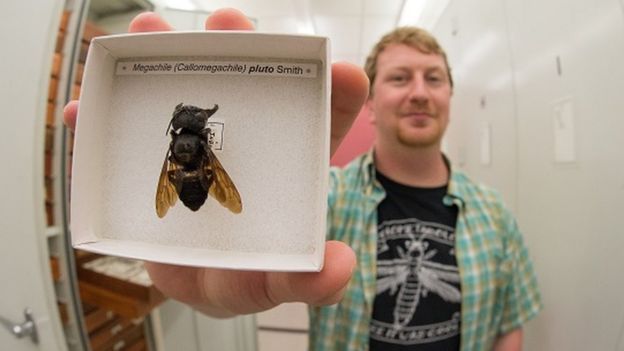
Image Copyright: CLAY BOLT
The world's biggest bee has been re-discovered after decades thought lost to science.
The goliath honey bee - which is up to a grown-up's thumb - was found on a little-investigated Indonesian island.
Following quite a while of looking, untamed life specialists found a solitary live female, which they captured and shot.
Known as Wallace's monster honey bee, the creepy crawly is named after the British naturalist and voyager Alfred Russel Wallace, who portrayed it in 1858.
Researchers found a few examples in 1981 on three Indonesia islands. It has not been seen alive since, in spite of the fact that there was a report a year ago of two honey bee examples being offered available to be purchased on the web.
In January, a group emulated Wallace's example on an adventure through Indonesia trying to discover and photo the honey bee.


Picture copyrightCLAY BOLT
Eli Wyman with one of only a handful few realized Wallace's monster honey bee tests
"It was totally stunning to see this 'flying bulldog' of a bug that we didn't know existed any longer, to have genuine verification directly there before us in the wild," said normal history picture taker, Clay Bolt, who took the first photographs and video of the species alive.
"To really perceive how delightful and huge the species is throughout everyday life, to hear the sound of its mammoth wings droning as it flew past my head, was simply mind-boggling. "
Wallace's giant bee (Megachile pluto)
- With an expected wingspan of over two inches (6 cm), Wallace's monster honey bee is the world's biggest honey bee
- The female makes her home in termite hills, utilizing her vast jaw to gather sticky tree tar to line the home and shield it from attacking termites
- The species relies upon essential swamp woodland for tar and the homes of tree-staying termites
- Wallace, who co-built up the hypothesis of advancement with Charles Darwin, portrayed the honey bee as, "a vast dark wasp-like bug, with monstrous jaws like a stag-creepy crawly".
The revelation, in the Indonesian islands known as the North Moluccas, raises trusts that the area's woods still harbor one of the rarest and most looked for after bugs on the planet.
There are presently no lawful securities around its exchange.
Excursion part and honey bee master Eli Wyman, an entomologist at Princeton University, said he trusted the rediscovery would start to examine towards a more profound comprehension of the existing history of the honey bee and illuminate any future endeavors to shield it from annihilation.
Wallace's mammoth honey bee is as of now recorded as defenseless against annihilation, as indicated by the International Union for Conservation of Nature.
Be that as it may, the global exchange of this species is as of now not limited by the Convention on International Trade in Endangered Species.
Natural gathering, Global Wildlife Conservation (GWC), which has propelled an overall chase for "lost species", bolstered the trek to discover the honey bee.
"By making the honey bee a world-renowned lead for protection, we are certain that the species has a more promising time to come than if we simply let it unobtrusively be gathered into blankness," said Robin Moore.
In January, the gathering reported they had discovered increasingly uncommon Bolivian frogs having a place with animal groups thought to be down to one male.


No comments:
Post a Comment
Paste Your Website and Article Link To Create Do-Follow Backlink